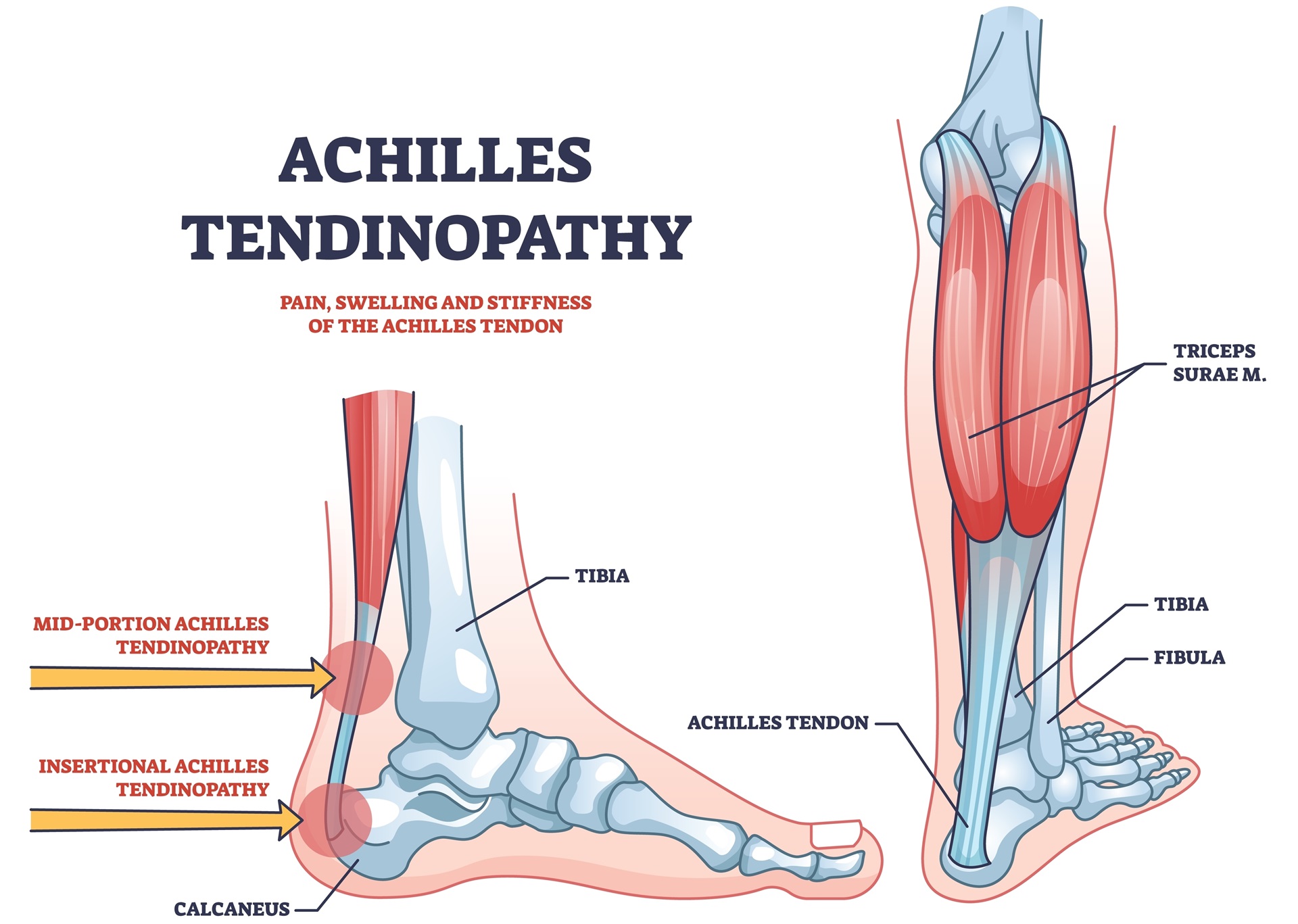Achilles Tendonitis

What is Achilles Tendonitis?
Achilles tendonitis is an overuse injury of the Achilles tendon, the band of tissue that connects the calf muscles to the heel bone. The Achilles tendon is the largest tendon in the body and plays a crucial role in walking, running, and jumping. When this tendon is subjected to repetitive stress or sudden increases in activity, it can become inflamed, leading to pain and swelling. Achilles tendonitis is common in athletes, particularly runners, but it can affect anyone, especially if they suddenly increase their activity level or wear improper footwear.
Symptoms of Achilles Tendonitis
Achilles tendonitis typically presents as pain and stiffness along the Achilles tendon, usually in the morning or after periods of rest. The pain may initially be mild and improve with activity, but it can worsen with prolonged exercise or intense physical activity. Other symptoms include
- Tenderness: The area around the tendon may be tender to touch, particularly 2-6 cm above the heel bone.
- Swelling: Swelling and thickening of the tendon may occur, especially in cases of chronic tendonitis.
- Limited Range of Motion: The ankle may feel stiff and less flexible, particularly when trying to flex the foot upward.
- Crepitus: A crackling or popping sensation may be felt when moving the ankle, indicating tendon inflammation.
Causes of Achilles Tendonitis
Achilles tendonitis often results from repetitive stress and strain on the tendon. Factors that can contribute to the development of Achilles tendonitis include
- Sudden Increase in Activity Level: A rapid increase in running distance, intensity, or frequency can overload the tendon.
- Improper Footwear: Shoes that lack proper arch support or cushioning, or those that are worn out, can place undue stress on the Achilles tendon.
- Foot Mechanics: Flat feet, high arches, or overpronation can cause the Achilles tendon to work harder, leading to inflammation.
- Tight Calf Muscles: Inflexible calf muscles can increase tension on the Achilles tendon, especially during physical activity.
- Age and Gender: Achilles tendonitis is more common in middle-aged men, but it can affect
- Sports Activities: Sports involving jumping, running, or sudden stops and starts, such as basketball, tennis, and soccer, can increase the risk of Achilles tendonitis.
Management of Achilles Tendonitis
Achilles tendonitis management focuses on relieving pain, reducing inflammation, and promoting healing. Treatment options include
- Rest and Activity Modification: Avoid activities that exacerbate the pain, such as running or jumping. Low-impact exercises like swimming or cycling can help maintain fitness without stressing the tendon.
- Ice Therapy: Applying ice packs to the affected area for 15-20 minutes several times a day can help reduce inflammation and pain.
- Stretching and Strengthening Exercises: Gentle stretches for the Achilles tendon and calf muscles can improve flexibility and reduce tension. Eccentric strengthening exercises are particularly beneficial in rehabilitation.
- Footwear and Orthotics: Wearing shoes with proper arch support and cushioned heels, or using custom orthotics, can reduce strain on the Achilles tendon.
- Shockwave Therapy: A non-invasive treatment that uses shock waves to promote healing and reduce pain. We offer shockwave therapy at our clinic for effective pain management.
- And Many More!
Why See a Podiatrist for Achilles Tendonitis?
Podiatrists are foot and ankle specialists who provide comprehensive care for Achilles tendonitis. They perform a thorough evaluation to determine the severity and underlying cause of the condition. A podiatrist can offer a range of treatments, from conservative options like custom orthotics and physical therapy to advanced interventions such as shockwave therapy or, in extreme cases, surgery. Additionally, a podiatrist can help develop a personalised rehabilitation program to strengthen the tendon, improve flexibility, and prevent future injuries, ensuring a safe and effective recovery.
